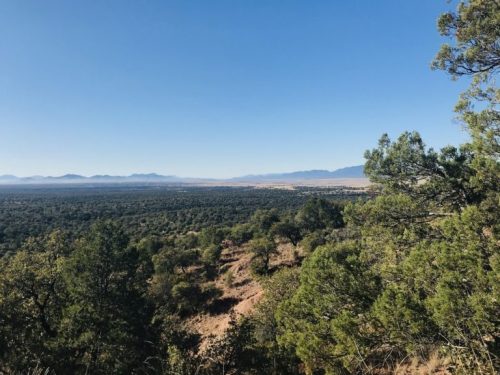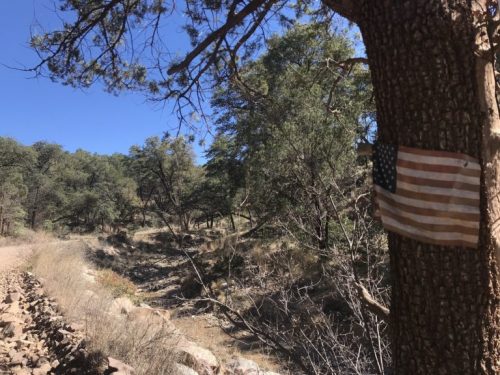By Sasha Hartzell/El Inde
In the high desert of southeastern Arizona, there is a vast range of grassland known by the local Border Patrol agents simply as ‘the valley.’
An aerial view of the region reveals a shape like cupped hands, the Huachuca and Patagonia Mountain ranges curving around a long, shadowed hollow: this is the San Rafael Valley, where the border is marked only with vehicle barriers — approximately 24 miles of steel rails welded into X’s, demarcating the southern edge of ‘the valley.’
It is a designated state natural area, home to the San Rafael Ranch and the headwaters of the international Santa Cruz River. It is constantly being surveilled by the Border Patrol agents posted in the mountains above.
Monitoring this segment of the border is the responsibility of the nearby Sonoita Station, created in 1989 to address what was seen as a glaring hole in border enforcement, according to the U.S. Customs and Border Enforcement website.
The station’s jurisdiction includes its namesake, Sonoita, as well as the towns of Patagonia and Elgin. It encompasses the valley, the surrounding mountains, and everything in between. In total, it covers an area of around 1,000 square miles — about the size of Rhode Island. The station’s initial eight agents had their hands full.
In the 31 years since, the Sonoita Station’s workforce has grown significantly: an estimated 231 agents now patrol the region, seven days a week and 24 hours a day. Concurrently, illegal traffic through the area has decreased from what it once was.
“The area used to be an open door for smuggling,” said Justin Bartine, Sonoita Station’s community liaison, “We closed that.” Just ten years ago, however, Bartine said traffic numbers were still crazy.

“You had to pick what you were going to do that day, what groups to respond to,” he said. Now, local agents are finding they have more flexibility in their ten-hour shifts.
While the Border Patrol agents still prioritize their primary mission — “to detect and prevent the illegal entry of aliens into the United States,” according to the Department of Homeland Security — they’ve found themselves using this flexibility to partake in a different kind of mission: local emergency response.
In the rural communities where they patrol, Sonoita Station agents have become the first responders, arriving early on scenes ranging from car accidents to lost hikers, from wildfires to domestic abuse. In a community in which the average wait time for law enforcement can be hours, it is a service generally much appreciated.
“We love Border Patrol,” said Joseph DeWolf, chief of the Sonoita-Elgin Fire Department. For small departments like his, which rely heavily on volunteers, DeWolf said lack of personnel is the biggest challenge — and one which the agents help alleviate.
DeWolf’s team has been collaborating with Border Patrol for as long as he has been there: 25 years. In the past decade, however, he said the relationship has become much stronger.
Formerly limited by a lack of agents, the Border Patrol now can now respond to calls for help 99% of the time, according to Bartine. “They used to call the station and ask for backup,” he said. “If we didn’t have anyone in the area, we didn’t have anyone to send. Now that we have the manpower, we have guys that are available all the time.”
At any given time of the day or night, 20-to-30 agents will be on shift — some patrolling the highway, some posted throughout the mountains. “Border Patrol has so many agents, they’re basically everywhere,” said Fire Chief DeWolf. “They’re first on scene and can size-up what we’re getting into.”
These Border Patrol agents also come with an intimate familiarity of the many rugged back roads surrounding Elgin, Patagonia and Sonoita — knowledge critical for local emergency response.
“We run around this country all the time, so we know a lot of the roads, we know where most of the fence lines are,” said Bartine. “We can get the fire department into where they need to be and start evacuating people left and right.”
Sue Archibald, a Sonoita resident whose neighborhood was evacuated for the 2017 Encino fire, remembers how Border Patrol “jumped right in and made themselves available however they could,” as the fire raged through the community.
In a region of grasslands that Bartine refers to as “one big tinder box,” extra hands are regularly needed. DeWolf said his fire department gets approximately 600 calls annually; Border Patrol agents act as first responders for around 50% of them. The other half, DeWolf described as minor calls not requiring additional support.
Some situations are routine: on average, local Border Patrol agents rescue at least five hikers per year, respond to one car crash per week, pull tourists’ vehicles out of muddy ditches every monsoon season, and change countless tires, according to Bartine.
Other situations, such as domestic abuse calls, are less common. “There’s a lot of stuff we’re not trained for,” said Bartine, “but we have to deal with it anyways.”
Though Border Patrol legally can’t enforce non-federal laws, such as speeding, drug use, or theft, they can still contain situations while waiting for local law-enforcement to arrive — typically a wait of at least an hour. The rapid response time can prevent a critical injury from becoming fatal.
In this alternate role, local agents contort their identity as border enforcers. “We kind of have to put on a different hat,” said Bartine. “Take off your BP hat, put on your EMT hat, and we have to interchange them all the time.”
The duality can complicate some community members’ opinions of the agency; even those who oppose Border Patrol’s ideology or actions may still find themselves thankful for their help. Bartine distinguishes the two roles: there is BP’s primary mission, border enforcement, and then there is helping the community.
“We have plenty of people that don’t agree with the primary mission for sure, but when we beat Patagonia Fire Department to a house fire in Patagonia, it’s hard to disagree with us being out there,” he said.
The help isn’t entirely selfless: the new 2020 Border Patrol strategy emphasized community involvement, according to Bartine. “I think the Border Patrol realized the need for the community to be involved and as supportive as they will be with the mission,” he said. “Us helping in any way with the community is a big bonus.”
Border Patrol counts on ranchers and other community members to alert agents of illegal border activity. Increased cooperation can also mean a decrease in headaches — local agents still encounter their share of hostility, particularly at the Border Patrol checkpoint just north of Sonoita.
But in Sonoita, unlike in Naco, where he was formerly stationed, Bartine said he doesn’t mind the community knowing he’s a Border Patrol agent. He lives there, his children go to school there, and he’s a familiar face to most. It’s what Archibald refers to as a ‘rural relationship.’
When the U.S. government shut down in 2018, and the Border Patrol agents stopped being paid, some local community members stepped in to help. “A lot of us took collections, bought gas cards and handed them out to our agents,” said Archibald. “They’re people we depend on, we try to help them.”
But the dependency on Border Patrol comes with no guarantees. If a border wall replaces the current vehicle barriers, the local agents’ shifts will likely change.
Instead of patrolling the entire region, Bartine anticipates that agents would have to lock into positions at intervals along the wall’s length — a strategy commonly used along already-walled portions of the border. With this significantly reduced mobility, local Border Patrol would likely lose their capacity to respond to community emergencies.
For now, Sonoita Station agents are free to roam, and free to act as first responders.
Editor’s note: A version of this story will appear in the summer 2020 special issue of the Patagonia Regional Times.

